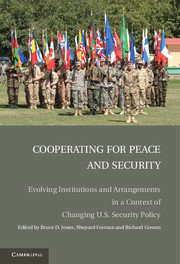 Cooperating for Peace and Security
Cooperating for Peace and Security Book contents
- Frontmatter
- Contents
- Contributors
- Foreword
- Acknowledgments
- I FRAMEWORK
- II ADAPTING COLD WAR INSTITUTIONS
- III NEW TOOLS, NEW MECHANISMS
- 10 Normative Evolution at the UN: Impact on Operational Activities
- 11 Constructing Sovereignty for Security
- 12 New Arrangements for Peace Negotiation
- 13 International Humanitarian Cooperation: Aiding War's Victims in a Shifting Strategic Environment
- 14 The Evolution of Regional and Subregional Collective Security Mechanisms in Post–Cold War Africa
- 15 International Courts and Tribunals
- IV CONCLUSIONS
- Index
- References
15 - International Courts and Tribunals
Published online by Cambridge University Press: 22 January 2010
- Frontmatter
- Contents
- Contributors
- Foreword
- Acknowledgments
- I FRAMEWORK
- II ADAPTING COLD WAR INSTITUTIONS
- III NEW TOOLS, NEW MECHANISMS
- 10 Normative Evolution at the UN: Impact on Operational Activities
- 11 Constructing Sovereignty for Security
- 12 New Arrangements for Peace Negotiation
- 13 International Humanitarian Cooperation: Aiding War's Victims in a Shifting Strategic Environment
- 14 The Evolution of Regional and Subregional Collective Security Mechanisms in Post–Cold War Africa
- 15 International Courts and Tribunals
- IV CONCLUSIONS
- Index
- References
Summary
One of the most visible changes brought about by the end of the Cold War to the structure, institutions, and discourse of international law and relations is the remarkable multiplication of international courts and tribunals and their increasing specialization and diversification. This chapter aims to verify the extent to which the evolution of the array of international courts since the end of the Cold War has followed the two major lines of development suggested in this volume's introduction (the adaptation of existing institutions and the creation of new ones), and how far it has matched the three phases identified by the editors as characterizing international relations (the end of the Cold War to 9/11, the phase between 9/11 and the invasion of Iraq, and the period from the fall of Saddam Hussein to the present day, at the time of this writing).
It is necessary to make some initial general observations and then delimit the scope of the analysis. The first general remark is that it is apparent that the development of international courts and tribunals has been largely haphazard and unplanned – perhaps inevitably so. Every court was born out of highly contingent situations, sometimes trying to replicate the success of previous experiments, and at other times, in reaction to past failures or the need to provide alternatives. Key players also have different attitudes and behaviors, changing from court to court and over time. It is all highly contextual.
- Type
- Chapter
- Information
- Cooperating for Peace and SecurityEvolving Institutions and Arrangements in a Context of Changing U.S. Security Policy, pp. 291 - 308Publisher: Cambridge University PressPrint publication year: 2009
References
- 1
- Cited by


